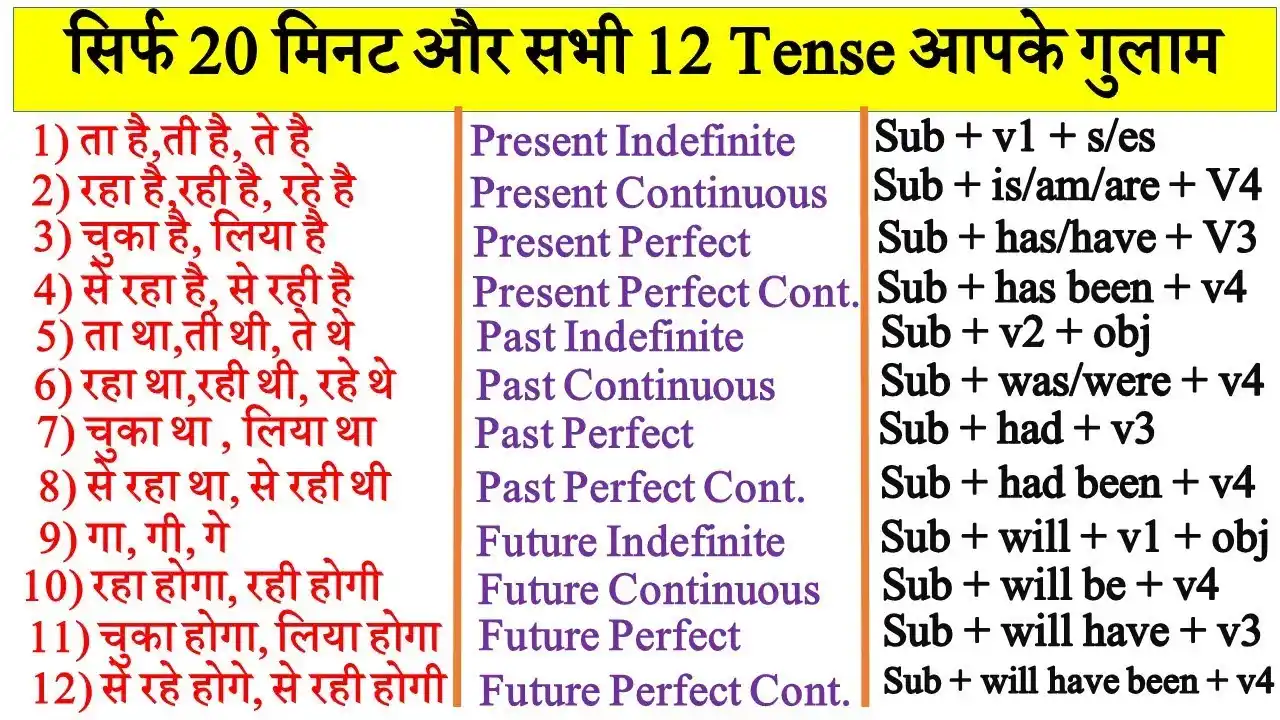Tense Chart with Rules and Examples PDF is a valuable resource for anyone learning English grammar. It helps to understand the different tenses—past, present, and future—along with their rules and proper usage. This chart simplifies complex grammar structures and provides clear examples for each tense. Whether you are a student or a teacher, having a tense chart handy allows for quick reference and better comprehension. Downloading a Tense Chart with Rules and Examples PDF will enhance your ability to form sentences accurately and improve your English communication skills effortlessly.
Tense Chart with Rules and Examples PDF: A Comprehensive Guide
Tenses are a crucial aspect of grammar that indicates the time of an action or event about the present moment. In English, there are various tenses, including past, present, and future, each of which can be further subdivided into simple, continuous, perfect, and perfect continuous forms. Understanding how to use tenses correctly is essential for effective communication and clarity in writing.
Each tense has its own rules and patterns for formation and usage. For example, we typically use the present simple tense for general truths or habits, while we use the present continuous tense for actions happening at the moment of speaking. We use the past simple tense to describe completed actions in the past, while we use the past continuous tense for actions that were in progress at a specific point in the past. We use the future simple tense to express predictions or plans for the future, while we use the future continuous tense to describe ongoing actions at a future point in time.
To communicate effectively in English, it is important to master the various tenses and understand how and when to use them in different contexts. By becoming familiar with the rules and patterns of each tense, writers can convey their ideas clearly and accurately, making their writing more engaging and coherent. With practice and study, anyone can improve their command of tenses and enhance their proficiency in English grammar.
Understanding English Verb Tenses: Rules and Examples
English verb tenses can be a bit tricky to understand, but they are essential for conveying the timing of actions or events in a sentence. The three main verb tenses in English are past, present, and future, with various forms and combinations to express different nuances. For example, the simple present tense is used to talk about habits, general truths, or regular actions, while the past tense is used to describe actions that have already happened.
Each tense has its own set of rules and structures that dictate how verbs are conjugated and used in a sentence. For example, in the present tense, regular verbs typically add an “-s” to the base form when used with third-person singular subjects, such as “He works” or “She sings.” Irregular verbs, on the other hand, have unique forms for each tense, like in the past tense “go” changes to “went” instead of just adding “-ed” like regular verbs.
To fully grasp the nuances of English verb tenses, it’s crucial to practice using them in context and pay attention to the specific rules and patterns that govern each tense. By mastering verb tenses, you can effectively communicate the sequence of events, actions, or states in your writing and speaking, making your language more precise and engaging.
Downloadable Tense Chart with Examples for Easy Reference
- Understanding verb tenses can be challenging for English learners, as they indicate when an action takes place and whether it is ongoing or completed. A tense chart with examples can serve as a helpful reference tool to ensure proper usage and comprehension of different verb forms. By having a visual representation of the various tenses, along with example sentences, learners can quickly reference this information for guidance when writing or speaking.
- Having a downloadable tense chart with examples allows learners to study and practice verb tenses at their own pace. This resource helps reinforce the rules and usage of each tense through practical examples that showcase how verbs change based on the specific time frame and context. With a quick and easy reference guide, learners can confidently apply the appropriate tense in their writing and conversations, improving their overall fluency and accuracy in English communication.
- Overall, a tense chart with examples provides a structured and organized way for English learners to review and master verb tenses. By having this tool readily available for reference, learners can feel more confident in their ability to use different tenses correctly, leading to better language proficiency and communication skills in both spoken and written English.
Mastering Grammar Tenses: A Step-by-Step Guide
- Mastering grammar tenses can be a daunting task for many language learners, but with a step-by-step approach, it can become much more manageable. The key is to break down the complex rules and structures of grammar tenses into smaller, more digestible chunks. Start by familiarizing yourself with the basic tenses – past, present, and future – and then gradually move on to more advanced tenses such as the perfect tenses, continuous tenses, and conditional tenses.
- One helpful strategy for mastering grammar tenses is to practice regularly through exercises and drills. This will not only help you understand the rules of each tense but also allow you to apply them in different contexts. By reading and listening to a variety of texts in the target language, you can naturally encounter different tenses, which enhances your understanding and usage of grammar tenses. Additionally, seeking feedback from teachers, tutors, or language exchange partners can provide valuable insights and corrections to further improve your skills.
- Lastly, consistency is key when it comes to mastering grammar tenses. Make it a habit to review and practice tenses regularly, and don’t be afraid to make mistakes. Learning a new language is a process, and mastering grammar tenses takes time and dedication. By following a step-by-step guide, practicing diligently, and seeking feedback, you can improve your proficiency in grammar tenses and become a more confident and effective communicator in your target language.
Tenses Flow Chart: Simplifying the Rules with Visuals
- A tenses flow chart is a visual aid that simplifies the rules for understanding and using different tenses in a language. It breaks down the various tenses into easy-to-follow steps, helping learners grasp the concept more effectively. Through a series of decision points and arrows, the flow chart guides users on when to use each tense based on specific criteria such as time frame, frequency, and completion of actions.
- By using a tenses flow chart, learners can quickly reference and apply the correct tense in their writing and speaking. This tool streamlines the process of selecting the appropriate tense, reducing confusion and errors in communication. It also enhances comprehension of the nuances between tenses, enabling users to convey precise meanings in their language use.
- Overall, language learners and educators alike find a tenses flow chart to be a valuable resource, as it offers a visual representation of how different tenses are structured and used. Its simplicity and clarity make it an effective tool for mastering the complexities of verb tenses and improving overall language proficiency. Whether for classroom instruction or self-study, a tenses flow chart can aid in building confidence and competence in using tenses correctly.
Hindi consonants are vital components of the language, forming the backbone of words and sentences. In Hindi, there are 33 primary consonants, each with unique sounds and pronunciations. These consonants include क (ka), ख (kha), ग (ga), घ (gha), च (cha), छ (chha), and many others. Understanding Hindi consonants is crucial for mastering reading, writing, and pronunciation. Each consonant can combine with vowels to create various syllables, enriching the language’s expressiveness. By familiarizing yourself with these consonants, you can enhance your Hindi language skills and communicate more effectively.






[…] Tense Chart with Rules and Examples PDF is an essential tool for understanding English grammar. It outlines the various tenses used in the […]